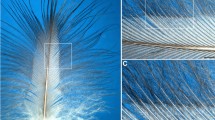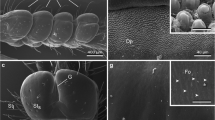Summary
Dart formation in Helix aspersa has been investigated by SEM of isolated darts at progressive stages in their development, and by histology of dart sacs at the same times. Dart formation begins at the tip of a tubercle where a small group of epithelial cells secrete an organic material filling a small CaCO3 cone that is the first mineralized part of the shaft. Subsequent secretory activity by an increasing area of the tubercle epithelium results in an increase in the diameter and anterior lengthening of the shaft. Continued secretion by the tubercle and dart sac epithelium produces the flare and finally the corona. A pattern of deposition is also evident in the fine structure of the mineral. In the shaft and vanes there is an inner layer of spherulitic prismatic structure which is covered by a layer of irregular patches of simple prismatic structure. The outermost layer of the shaft and vanes has a continuous simple prismatic structure. Two layers are present in the flare, an inner granular amorphous layer and an outer spherulitic prismatic layer. The corona consists of a single rarefied prismatic layer. A mechanism of dart formation is suggested that involves two types of organic matrix, calcifying and non-calcifying. Measurements of the calcium content of darts, dart sacs, and collars indicate that the hemolymph is the probable source of calcium for the dart.
Similar content being viewed by others
References
Abolins-Krogis A (1968) Shell regeneration in Helix pomatia with special reference to the elementary calcifying particles. In: Fretter V (ed) Studies in the structure, physiology, and ecology of molluscs, Academic Press, London, pp 75–92
Bronn HG (1928) Klassen und Ordnungen des Tier-Reichs. Mollusca II. Gastropoda 2. Pulmonata. Vol. III. Akademische Verlagsgesellschaft, Leipzig, p 1354
Campion M (1961) The structure and function of the cutaneous glands in Helix aspersa. J. Micros Sci 102:195–216
Crenshaw MA, Ristedt H (1975) Histochemical and structural study of nautiloid septal nacre. Biomineralization 8:1–8
Hunt S (1979) The structure and composition of the love dart (gypsobelum) in Helix pomatia. Tissue Cell 11:51–61
Meenakshi VR, Blackwelder PL, Wilbur KM (1973) An ultrastructural study of shell regeneration in Mytilus edulis (Mollusca: Bivalvia). J Zool London 171:475–484
Meenakshi VR, Donnay G, Blackwelder PL, Wilbur KM (1974a) The influence of substrate on calcification patterns in molluscan shell. Calc Tissue Res 15:31–44
Meenakshi VR, Martin AW, Wilbur KM (1974b) Shell repair in Nautilus macromphallus. Marine Biol 27:27–35
Müller OF (1973/74) Vermivm terrestrium et fluviatilium, seu animalium infusoriorum, helminthicorum et testaceorum, non-marinorum, succincta historia, auctore Orthone Friderico Müller, Havniae et Lipsia, apud Heineck et Faber.
Simkiss K (1976) Cellular aspects of calcification. In: Watabe N, Wilbur KM (eds) Mechanisms of calcification in invertebrates and plants. University of South Carolina Press, Columbia, pp 1–31
Standen R (1892) Observations on the reproduction of the dart during an attempt to breed from a sinistral Helix aspersa. J Conch 7:33–38
Taylor JD, Kennedy WJ, Hall A (1969) The shell structure and mineralogy of the Bivalvia. Introduction, Nuculacea-Trigonacea. Bull Br Mus (Nat Hist) Zool (Suppl. 3) pp 1–125
Tompa A, Wilbur KM (in press) X-radiographic examination of dart formation in Helix aspersa. Neth J Zool
Watabe N, Meenakshi VR, Blackwelder PL, Kurtz EM, Dunkelberger DG (1976) Calcareous spherules in the gastropod, Pomacea paludosa. In: Watabe N, Wilbur KM (eds) Mechanisms of calcification in invertebrates and plants. University of South Carolina Press, Columbia, pp 283–308
Author information
Authors and Affiliations
Rights and permissions
About this article
Cite this article
Dillaman, R.M. Dart formation in Helix aspersa (Mollusca, Gastropoda). Zoomorphology 97, 247–261 (1981). https://doi.org/10.1007/BF00310279
Received:
Issue Date:
DOI: https://doi.org/10.1007/BF00310279




